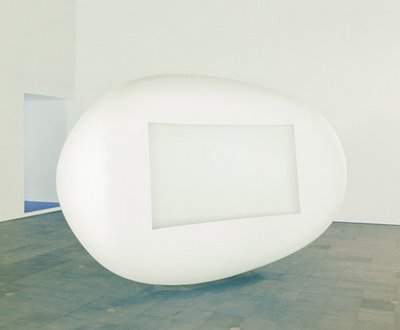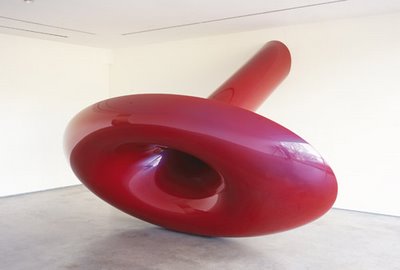Anish Kapoor interview

I spoke with Anish Kapoor at his exhibition “Anish Kapoor: Past, Present, Future” at Boston’s Institute of Contemporary Art on May 27, 2008. Below are excerpts from that interview:
- “Art at one level is effect. And art is illusion. So I’ve always believed that the illusionistic in a way is allowed. Now in the age of Disney we have a certain association with the notion that anything illusionistic is also trivial. And I suspect that the true and deeper illusions are not trivial at all, they’re very profound.
“At a simple level let’s take a work like ‘Iris,’ which is for me it’s a recessed concave mirror. For me it’s not a mirrored object or the illusion that it gives of upsidedownness or whatever. For me it’s a space full of mirror. And that does something quite different from any mirror that you’ve ever looked at. It’s a space full of mirror. There’s something ethereal about it. There’s something not quite real about it. There’s a kind of virtualness to it. I think it’s a new kind of space. It’s a new proposition, a new idea about the way space is affected, about the status of an object. It’s not quite there. And that’s why I’m interested in it.
“’S-Curve’ does something in a way quite similar. At one level, yes, it’s a fun house mirror, it turns you upside-down and so on. But as an object in the space it has a kind of uncertainty let’s say about its own status. Is there dignity in that? Where does that bring us? I think that brings us to all sorts of places. Some of which are performative, cinematic. Some of which tell us, maybe, that it’s the skin of an object that describes its conditions in the world. That those last few microns on the surface apparently reveal what’s inside, but in actually probably don’t. So there’s a whole lot of kind of discourse for me anyway about the status of an object and it’s various projected realities." - “One wants to have as many fugitive meanings as possible. Why not? Because in the end all seriousness can be pitched in different ways. Perhaps there’s intellectually no problem with it tying itself to various kinds of, whether its sci-fi, popular culture, these kinds of fugitive meanings. Why not? … It’s the same thing that’s being talked about. There’s a history in this kind of mystical language of whether we go from cabalistic imagery to, I don’t know, Aleister Crowley and those dark magic images to science fiction. There’s a very easily traceable line. I suppose it does tell us about some yearning that we have in different aspects of culture to step beyond the banality of the everyday. And that there are certain phenomenon – light and darkness, apparition, disappearing, half-revealed, etcetera – that are phenomena that we see in the world, recognize in the world and that are applied to all of these things across the board, that reemerge across the board. In a way I have a feeling that the modern, as opposed to the post-modern, the modern now, this modern, this ultra-modern somehow needs to reengage with some of that stuff."
- “The minimalists, of course, were very, very concerned with the idea that ‘What you saw was what you saw.’ That’s it, it’s there, nothing else. Now, I’m afraid I don’t believe that. I’m afraid I believe that what you see isn’t what you see. It’s never what you see. It never was what you see.”
- “I think we learned two or three things [from that]. One of them is that there’s no such thing as abstract art, which I quite like. And that our ability to project meaning, our need to project meaning is so all encompassing that we do it given just the smallest amount of information. And that as an artist one can direct that need for meaning. I think that’s one of the things I’m really engaged in.”
- “I’m really interested in two or three things. One of them is I want to make things that have a kind of attraction-repulsion sense in them. But I don’t want to state that too obviously. I don’t feel I want to make props for a movie. So that sense when you look at something it’s almost as if I’ve got somewhere like that in my body, or rather I’ve seen it somewhere else. That sense of a kind of recognition which can both be compelling and the opposite.
“Much of the imagery, many of the forms I’ve worked with over the years are very sexual. Let’s say that the modernist tradition in form – which is only one way of speaking about it, but why not – is mostly phallic, mostly upward and onward, and it leads to the rocket and the spaceship. I have a feeling that the truly modern, meaning modern of today, the ultra-modern form is inside-out. And I’m trying to look for it. I try to look for inside-out forms. If one could say there’s a shape to the Internet, I’d say it was inside-out. Or rather involuting. That’s one way of talking about something.
“Now, I like the idea that there’s a kind of little space on the inside of your armpit that has a – I know it, you know it, we all know it, it’s there as something, it’s a basic, it’s a kind of hollow that we instantly recognize. I want to get there, I want to get to that. Sometimes it’s an asshole, sometimes it’s vaginal. And I think that’s okay. That’s part of this, if you like, adventure. So the anthropomorphizing of the idea of an involuted form is something I’m engaged with.” - “There was representation. Then there was – and I’m really horribly paraphrasing, but anyway – then there’s cubism, meaning the world is broken into bits, the world is sort of taken apart. Then one has to say there’s the reassembling of wholeness – Brancusi and etcetera. I propose that the next new form is upside-down, inside-out, turning itself, only partially revealing itself. Now necessarily that is dark, sexual, underground and what Freud called the uncanny. It’s necessary, it’s part of the process. Phallic form seems to me to say onwards, upwards, we’re looking to the light, we’re looking outward. And involuted form seems to say – you know to use a Platonic metaphor – we’re not looking from the cave out to that light, which is marvelous. We’re actually looking at the back of the cave, over there, to where it’s dark and dirty and dangerous and smelly and sexual and, you know, half-revealed. And I think that’s the way it should be. Oh, God, it’s much more mysterious back there than all that [in the light]. That’s an idea about progress, about onward and upward. Look where it’s got us. Back there I think is true mystery, is true human profundity, it’s where we come from and it’s probably where we go.”

Pictured from top to bottom: Anish Kapoor, Untitled, 1998, and “Inwendig Volle Figur,” 2006.






0 Comments:
Post a Comment
<< Home